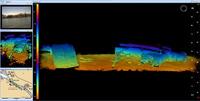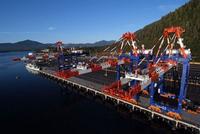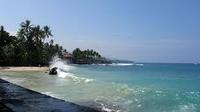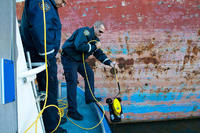-
Long Beach Police Department purchases underwater inspection system for port

The Port of Long Beach is the second busiest seaport in the United States and is a major gateway for trade with Asia, handling more than six million containers annually; to enhance port security, the City of Long Beach Police Department has purchased an Underwater Inspection System (UIS) from Cod Octopus
-
-
Men in maritime disasters save themselves first --“women and children first” is a myth

Since the sinking of the Titanic, there has been a widespread belief that the social norm of “women and children first” gives women a survival advantage over men in maritime disasters, and that captains and crew members give priority to passengers; a new study find that the Titanic disaster, in which 70 percent of the women and children on board were saved compared to 20 percent of the men, is a glaring exception to the rule; during maritime disasters, men use their relative strength to save themselves; what is more, studies of human behavior during natural disasters show the same results: in life-and-death situations, it is every man for himself
-
-
U.S. agency critical of Canadian ports' security

The U.S. Federal Maritime Commission has issued a report criticizing Canadian sea ports for lax security. The commission reports singled out Prince Rupert port in British Columbia as an especially egregious case of insufficient security for U.S.-bound cargo
-
-
Northrop Grumman delivers Nationwide AIS to Coast Guard
Northrop Grumman has delivered its Nationwide Automatic Identification System (AIS) to the Coast Guard; the system provides a more comprehensive view of vessels bound for and navigating within U.S. ports and waterways
-
-
ONR sensor and software suite tracks, hunts down more than 600 suspect boats
A new sensor and software suite sponsored by the Office of Naval Research recently returned from West Africa after helping partner nations track and identify target vessels of interest as part of an international maritime security operation
-
-
More effective radiation detection of cargo, baggage

A new technique for radiation detection that could make radiation detection in cargo and baggage more effective and less costly for homeland security inspectors; the novel detection method relies on spectral shape discrimination (SSD), taking advantage of a new class of nanoporous materials known as metal-organic frameworks (MOFs)
-
-
Exploring the Bermuda Triangle's swirling vortices

Researchers, funded by the Office of Naval Research, deployed twenty-one underwater probes to study vortices at the Bermuda Triangle; a vortex is a swirl of water that can be created in several ways, including water being pushed between land masses and then released into the open ocean; the oceanographers did well to lose only one of the underwater probes, considering they were studying the notorious Triangle
-
-
High-seas piracy? There will soon be an app for that
The U.S. Navy is sponsoring research aiming at developing Web applications to help multinational navies police the world’s oceans
-
-
CBP tests streamlined cargo security procedure
U.S. Customs & Border Protection’s (CBP) launched Simplified Entry Pilot, which allows participants to file a streamlined data set much earlier in the import process, thus providing more time to identify security threats
-
-
NY-NJ Port Authority centralizes security operations
The Port of Authority of New York and new Jersey has created a stand-alone Security Department and is now searching for a Chief Security Officer to oversee all security and safety functions, resources, and personnel
-
-
Lego pirate proves, survives, super rogue wave
Scientists have used a Lego pirate floating in a fish tank to demonstrate for the first time that so-called “super rogue waves” can come from nowhere in apparently calm seas and engulf ships
-
-
New cargo screening unveiled
Smiths Detection’s new HCVMe uses the power of a 4MeV X-ray accelerator and can scan loaded cargo containers with a steel penetration of 200 mm
-
-
Coast Guards blocks Hawaii bay to protect president

The Coast Guard has established a security zone in the waters of Kailua Bay to protect the president on his family during their holiday vacation; unauthorized people entering the zones are subject to penalty of $40,000 for each violation or a criminal penalty resulting in imprisonment of twenty-five years; the exclusion zone will be in effect until 7 January
-
-
Underwater drones help NYPD secure harbor

The New York Police Department (NYPD) has a new high-tech ally in its fight to keep the city safe from terrorists; to help sweep the city’s waterways and bridges of dangerous bombs, the NYPD’s Harbor Unit recently acquired six unmanned underwater drones that help sniff out explosives
-
-
Underwater drones help police keep harbors safe
Growing attention to underwater security along U.S. coasts has resulted in an increasing reliance on a relatively new tactical weapon for the police: an unmanned submersible drone, often referred to as a remote-operated vehicle, or ROV. The NYPD has six of these underwater drones, similar to those in use by the United States military and by oil companies with offshore operations.
-
- All
- Regional
- Water
- Biometrics
- Borders/Immig
- Business
- Cybersecurity
- Detection
- Disasters
- Government
- Infrastructure
- International
- Public health
- Public Safety
- Communication interoperabillity
- Emergency services
- Emergency medical services
- Fire
- First response
- IEDs
- Law Enforcement
- Law Enforcement Technology
- Military technology
- Nonlethal weapons
- Nuclear weapons
- Personal protection equipment
- Police
- Notification /alert systems
- Situational awareness
- Weapons systems
- Sci-Tech
- Sector Reports
- Surveillance
- Transportation
Advertising & Marketing: advertise@newswirepubs.com
Editorial: editor@newswirepubs.com
General: info@newswirepubs.com
2010-2011 © News Wire Publications, LLC News Wire Publications, LLC
220 Old Country Road | Suite 200 | Mineola | New York | 11501
Permissions and Policies
Editorial: editor@newswirepubs.com
General: info@newswirepubs.com
2010-2011 © News Wire Publications, LLC News Wire Publications, LLC
220 Old Country Road | Suite 200 | Mineola | New York | 11501
Permissions and Policies
